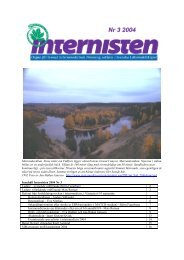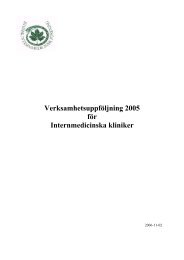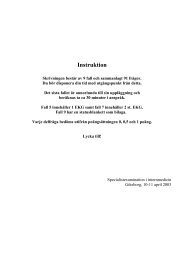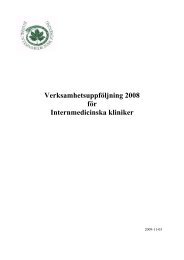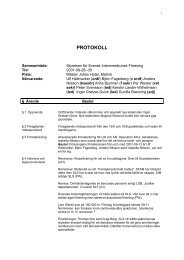Instruktion
Instruktion
Instruktion
You also want an ePaper? Increase the reach of your titles
YUMPU automatically turns print PDFs into web optimized ePapers that Google loves.
Vol. 334 No. 21 CARVEDILOL AND MORBIDITY AND MORTALITY IN CHRONIC HEART FAILURE 1353<br />
Probability of Event-free Survival<br />
NO. AT RISK<br />
Placebo<br />
Carvedilol<br />
1.00<br />
0.95<br />
0.90<br />
0.85<br />
0.80<br />
0.75<br />
0.70<br />
0.65<br />
0.60<br />
0.55<br />
0 50 100 150 200 250 300 350 400<br />
398<br />
696<br />
336<br />
607<br />
292<br />
529<br />
Days of Therapy<br />
260<br />
491<br />
134<br />
270<br />
63<br />
117<br />
Figure 2. Kaplan–Meier Analysis of Survival without Hospitalization<br />
for Cardiovascular Reasons (Event-free Survival) in the Placebo<br />
and Carvedilol Groups.<br />
Patients in the carvedilol group had a 38 percent lower risk of<br />
death or hospitalization for cardiovascular disease than patients<br />
in the placebo group (P0.001).<br />
safety of carvedilol when it is administered without rigorous<br />
supervision or in bedridden patients with advanced<br />
heart failure.<br />
To enhance the safety of patients, therapy with carvedilol<br />
was initiated in small doses that were gradually<br />
increased over a period of several weeks. This cautious<br />
approach has been followed in studies of other betablockers<br />
12-20,34 and is designed to minimize the adverse<br />
effects that may occur after the abrupt withdrawal of<br />
the homeostatic support provided by the sympathetic<br />
nervous system. Despite such care, however, the frequency<br />
of early side effects was expected to be high<br />
enough potentially to unblind both the patient and the<br />
investigator as to the treatment-group assignment. To<br />
avoid this difficulty, we required patients to complete a<br />
two-week, open-label period before randomly assigning<br />
them to double-blind therapy; this design feature has<br />
been part of many trials studying survival in heart<br />
failure 19,35,36 and of all previous controlled trials with<br />
carvedilol. The use of an open-label period not only allows<br />
drug-related side effects to subside before randomization<br />
(thus maintaining the blindedness of the study)<br />
but also enhances the study’s power, since a trial is less<br />
likely to detect a true effect on survival if patients are<br />
randomly assigned to treatment that cannot be maintained<br />
for the planned length of the study. Although<br />
deaths may occur during the open-label period, they<br />
cannot be validly assigned to either the treatment or<br />
the placebo group, since they may be related either to<br />
the natural history of heart failure or to carvedilol. Fortunately,<br />
the mortality rate during the two-week, openlabel<br />
period was low (0.6 percent) and was similar to —<br />
if not less than — the rate in the preceding three weeks<br />
(1.7 percent), during which patients were being screened<br />
CAPS:CAPS Shipped Pages:may23.96:1pack.oa<br />
Wed May 22 96 12:05:16<br />
45<br />
92<br />
Carvedilol<br />
Placebo<br />
35<br />
70<br />
2<br />
9<br />
for the program but were receiving only their usual<br />
medications for heart failure.<br />
Our findings should be interpreted with the knowledge<br />
that the trial program had several unusual characteristics<br />
for a study of the effect of a drug on survival.<br />
Most such trials are designed as long-term studies in<br />
which nonfatal events are considered to be secondary<br />
end points. In our program, however, the individual<br />
protocols were designed first to evaluate nonfatal end<br />
points as components of a single stratified trial program,<br />
and then mortality was specified a priori to assess<br />
safety and potential benefit. As a result, the duration<br />
of follow-up was short and fixed. Although several<br />
trials examining mortality in heart failure have also<br />
used a fixed follow-up period, 19,37 such a design necessarily<br />
reduces the number of events that can be observed.<br />
This explains why, although the annual mortality<br />
in our placebo group (14 to 15 percent) was similar<br />
to that in many studies, 35,38 we recorded only 53 deaths<br />
(since the average follow-up was only 6.5 months). This<br />
limited experience restricts our ability to reach conclusions<br />
about the true magnitude or persistence of any effect<br />
on survival. Yet it should be noted that the number<br />
of events during follow-up in our trial was not small if<br />
morbidity and mortality are combined; 25 percent of<br />
the placebo group died or were hospitalized for cardiovascular<br />
reasons, and this combined rate was substantially<br />
lower in the carvedilol group. Furthermore, a long<br />
follow-up period may not be possible if the finding of a<br />
large treatment effect leads the Data and Safety Monitoring<br />
Board to recommend early termination of a<br />
study, as occurred in this case; the mean duration of follow-up<br />
in the present program was similar to that in<br />
REACTION<br />
Table 4. Most Frequent Adverse<br />
Reactions.*<br />
PLACEBO<br />
(N398)<br />
CARVEDILOL<br />
(N696)<br />
Dizziness<br />
no. (%)<br />
80 (20) 233 (33)<br />
Fatigue 93 (23) 177 (25)<br />
Dyspnea 101 (25) 150 (22)<br />
Upper respiratory tract infection<br />
74 (19) 133 (19)<br />
Heart failure 84 (21) 111 (16)<br />
Chest pain 61 (15) 104 (15)<br />
Hyperglycemia 34 (9) 88 (13)<br />
Diarrhea 24 (6) 83 (12)<br />
Increase in weight 30 (8) 71 (10)<br />
Cough 40 (10) 58 (8)<br />
Pain 33 (8) 62 (9)<br />
Headache 30 (8) 57 (8)<br />
Nausea 18 (5) 60 (9)<br />
Hypotension 15 (4) 60 (9)<br />
Asthenia 27 (7) 49 (7)<br />
Bradycardia 4 (1) 65 (9)<br />
Worsening renal function 20 (5) 46 (7)<br />
Vomiting 18 (5) 46 (7)<br />
*Patients may have had more than one adverse reaction.



